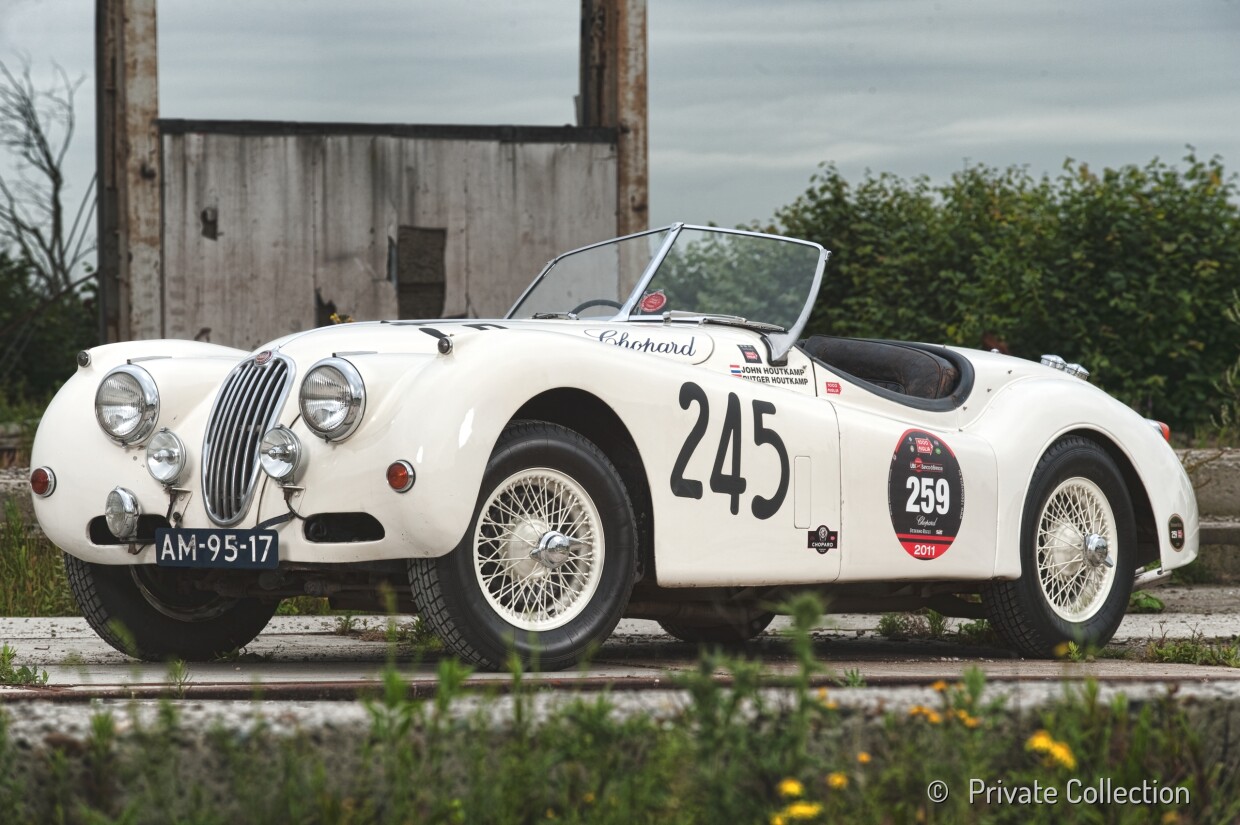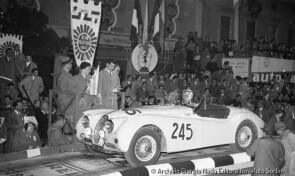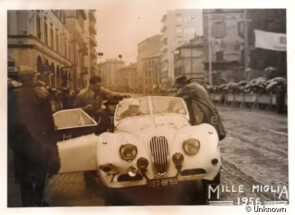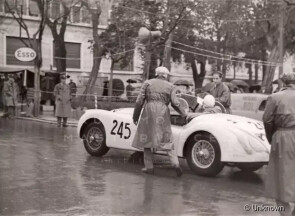
1955 Jaguar XK 140 OTS
ON/OFF
Why am I an Automotive Masterpiece?
L. Limited edition cars
no. 3 manufactured. 1 of 3 Jaguar XK140 OTS works set up by Jaguar for the 1956 Mille Miglia
If there is one brand unmistakably linked to the concepts and philosophy of luxury and sports performance, it is Jaguar. The Jaguar XK 140 is a sports car manufactured by Jaguar between 1954 and 1957 as the successor to the XK 120. Upgrades included increased interior space, improved brakes, rack-and-pinion steering, greater suspension travel, and telescopic shock absorbers replacing the older lever-arm design. The XK 140 was introduced in late 1954 and sold as a 1955 model. Exterior changes that distinguished it from the XK 120 included more substantial front and rear bumpers with overriders and flashing turn signals (operated by a switch on the dash) above the front bumper. The grille remained the same size but became a one-piece cast unit with fewer, broader vertical bars. The Jaguar badge was incorporated into the grille surround. A chrome trim strip ran along the center of the bonnet (hood) and boot (trunk) lid. An emblem on the boot lid contained the words "Winner Le Mans 1951–3". The interior was made more comfortable for taller drivers by moving the engine, firewall, and dash forward, providing 3 inches (76 mm) more legroom. The OTS was the sportiest and most essential option, while the DHC and FHC offered greater comfort and practicality. The Drop-Head Coupé (DHC) had a bulky lined canvas top that lowered onto the body behind the seats, a fixed windscreen integral with the body, wind-up side windows, and a small rear seat. It also featured a walnut-veneered dashboard and door cappings. The Fixed Head Coupé (FHC) shared the DHC's interior trim and rear seat. The prototype Fixed-Head Coupé retained the XK 120 Fixed Head roof profile, with the front wings and doors identical to those of the Drophead Coupé. Production cars had the roof lengthened, the windscreen placed further forward, shorter front wings, and longer doors, all of which resulted in easier entry and more interior space and legroom. Two 6-volt batteries, one in each front wing, were fitted to the Fixed-Head Coupé, while the Drop-Head Coupe and the Open Two-Seater had a single 12-volt battery installed in the passenger-side front wing. The XK 140 was powered by the 3.4-litre Jaguar XK inline-six engine, designed by William Heynes, incorporating the Special Equipment modifications from the XK 120. These increased the specified power by 10 bhp to 190 bhp gross at 5,500 rpm as standard. The optional C-Type cylinder head, carried over from the XK 120 catalogue, produced around 210 bhp at 5,750 rpm. When fitted with the C-Type head, 2-inch sand-cast H8 carburetors, heavier torsion bars, and twin exhaust pipes, the car was designated XK 140 SE in the UK and XK 140 MC in North America. In 1956, the XK 140 became the first Jaguar sports car to be offered with automatic transmission. As with the XK 120, wire wheels and dual exhausts were optional, with most XK 140s imported into the United States featuring the optional wheels. Cars with standard disc wheels had spats (fender skirts) over the rear wheel opening. Factory-spec 6.00 × 16-inch cross-ply tires or optional 185VR16 Pirelli Cinturato CA67 radial tires could be fitted on either 16 × 5K½ solid wheels or 16 × 5K (Special Equipment) wire wheels. A stock XK 140 SE could achieve a top speed of 120–125 mph (193–201 km/h). Road & Track's XK-140 MC test in June 1955 recorded a best two-way average of 120.3 mph (193.6 km/h). The best one-way run was 121.1 mph (194.9 km/h). Sports Cars Illustrated's test of the same model in August 1957 recorded its fastest two-way average at 121 mph (195 km/h). Their best one-way run was 124 mph (200 km/h). Karl Ludvigsen's test published in Sports Car World (July 1957) had the same results as the SCI test. Acceleration from 0–60 mph (97 km/h) was recorded at 8.4 seconds, 9.1 seconds, and 9.1 seconds, respectively. Only the R&T test attempted 0–100 mph (161 km/h), which took 26.5 seconds. Standing 1/4-mile (~400 m) times were 16.6 seconds at 82 mph (approximately 132 km/h) and 16.9 seconds at 86 mph (138 km/h). According to the Jaguar Heritage Trust, a total of 3,349 cars were built: 73 in right-hand drive and 3,276 in left-hand drive configuration.
The Roadster (designated OTS - Open Two-Seater) was the sportiest and most essential version of the XK 140. With its lightweight design and open cockpit, it was aimed at driving enthusiasts who valued performance over comfort. The OTS featured a light canvas top that folded completely out of sight behind the seats. The interior was trimmed in leather and leatherette, including the dashboard. Like the XK 120 Roadster, the XK 140 OTS had removable canvas and plastic side curtains on light alloy barchetta-type doors, and a tonneau cover. The door tops and scuttle panel were cut back by two inches (50 mm) compared to the XK 120, improving steering wheel positioning and driver ergonomics. The front face of the doors (A-Post) was redesigned from 45 to 90 degrees, allowing easier entry and exit. The windscreen remained removable, maintaining a pure open-air driving experience. While Jaguar’s XK 120 had already established the brand as a dominant force in motorsport, the XK 140 OTS carried forward this racing pedigree. Although it was not a full-fledged race car, it was frequently used in privateer racing and endurance events, particularly in the United States, where amateur drivers competed in SCCA (Sports Car Club of America) races. The Jaguar XK140 Open Two-Seater (OTS) was produced in 3,347 units between 1954 and 1957.
Jaguar XK 140 OTS with chassis no. S800035DN was built as one of the only 3 Works Jaguar XK 140s.The other two, S800033DN and S800034DN were painted British Racing Green, but S800035DN was painted white Cream: the favourite colour of its driver Ian Appleyard, one of the most successful rally drivers of its decade. After the car was sold by Jaguar, it went to France and has been delivered to Mr. Georges Guyot. He drove the car at the 1956 Mille Miglia, finishing in 14 hours, 7 minutes and 15 seconds, ranking 40th overall and winning its class ("Sports cars with price limit, not exceeding Lit. 2.000.000"). Guyot drove the car quite a lot: as can be seen by the oil service paper, the Jaguar had driven almost 50.000 kilometers in 1959. The average amount of kilometers was not reached in the following years: in 1998 the Jaguar had only driven 93.240 kilometers since new. Chassis no. S800035DN was bought in 1966 by the French family Jacquin. Only two owners within the family have had the car since the 10th of february 1966. This example is 1 of the only 73 original Right Hand Drive Jaguar XK 140 OTS’s on a total of 3349 cars built. Furthermore, this example, as 1 of only 36, has the Special Equipment option (MC specification), with C Type head engine and wire wheels. Special equipment includes the optional overdrive. Nowadays the Jaguar is in original condition and in the same specification as it drove the Mille Miglia in 1956. The Jaguar still has its original engine, cylinder head and gearbox (matching numbers). it still has its original soft-top, leather interior, louvres on the bonnet and double petrol filler caps which you can recognize on the old Mille Miglia pictures. Current owner is the 3rd owner of the car from 2010. The car has covered only 108.000 km since new.






